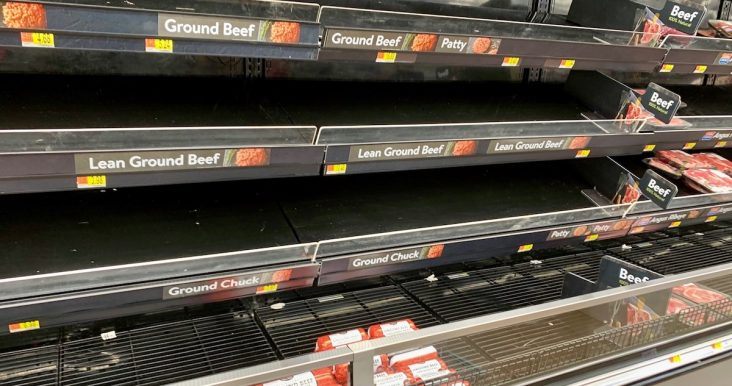Meat production threatened with disruption; shortages expected
by April 13, 2020 3:01 pm 1,909 views

The U.S. meat industry has seen production capacity decline as a result of COVID-19. Derrell Peel, livestock marketing analyst with Oklahoma State University, said reduced capacity could cause backups in live animal supplies if slaughter and processing are delayed.
The severity of impacts will depend on specific situations and locations but could include costly delays in holding animals until slaughter, backlogs in production facilities, or even disposal of animals, Peel said.
Smithfield Foods said this week it would idle production in is Sioux Falls, S.D., pork processing plant as cases of COVID-19 rose among its workforce to more than 200 in recent days. The plant closure accounts for about 4%-5% of the nation’s pork production. This is on top of the Tyson Foods pork processing plant shuttered recently in Columbus Junction, Iowa, which has a slaughter capacity of 10,100 hogs a day, or 2% of the U.S. capacity.
“The closure of this Sioux Falls facility, combined with a growing list of other protein plants that have shuttered across our industry, is pushing our country perilously close to the edge in terms of our meat supply,” Smithfield’s CEO Ken Sullivan said in a statement. “It is impossible to keep our grocery stores stocked if our plants are not running.”
Peel said the severity of impacts depends on specific locations, but there are costly ramifications for feedlots when there are delays in slaughter production. The Smithfield closure is one of four meat plants shuttered recently because of COVID-19 concerns. Tyson Foods shuttered a meat plant in Iowa, and Cargill closed a plant in Pennsylvania reporting 160 COVID-19 cases. National Beef temporarily closed processing and slaughter facility for deep cleaning to fend off the COVID-19 threat.
Tyson Foods and Sanderson Farms have said they have poultry processing plants with reduced capacity as absences are higher than normal because of COVID-19.
“Such disruptions could result in reduced flows of fresh meat to consumers, compounded by the continuing bottlenecks created by the drastic reduction in the foodservice sector, roughly half of total food distribution. Since early March, those bottlenecks resulted in limited meat availability in retail grocery despite an ample supply of meat production. The next few weeks could result in continuing shortages of meat at retail grocery due to a short-run reduction in processing capacity and reduced supplies of all meats. Wholesale and retail meat prices may be pushed higher as a result of limited supply. At the same time, limited processing capacity may limit demand for slaughter animals and push farm level prices lower,” Peel said.
The impacts are likely already showing up in the beef industry, Peel said. Estimated cattle slaughter for the week ended April 11 was 536,000 head, down 14% from the previous week and nearly 16% lower than the same week last year. The reductions include yearling (steer and heifer) slaughter as well as cow and bull slaughter with both categories down double digits year over year for the week, he added. He said this situation of not being able to slaughter animals in a timely manner is a new problem for the industry.
“In the current situation, closure or reduced chain speeds across multiple plants may make it impossible to keep up with slaughter,” he said.
Peel said feedlots could be faced with slowing fed cattle finishing or holding animals on maintenance rations until slaughter can be scheduled. Cull cows and bulls may have to be held in drylots or pastures until slaughter capacity becomes available. A slowdown in feedlot marketings could result in slower feedlot placements and more feeder cattle staying on pasture.
“The beef industry ultimately has considerable flexibility to adjust cattle flows and timing. These responses would increase the cost of production at all levels but probably would not be as severe as might result from similar disruption in pork and poultry industries where bottlenecks and backlogs are much more acute. The next few weeks could be an unparalleled challenge for livestock producers, processors and consumers,” Peel said.
